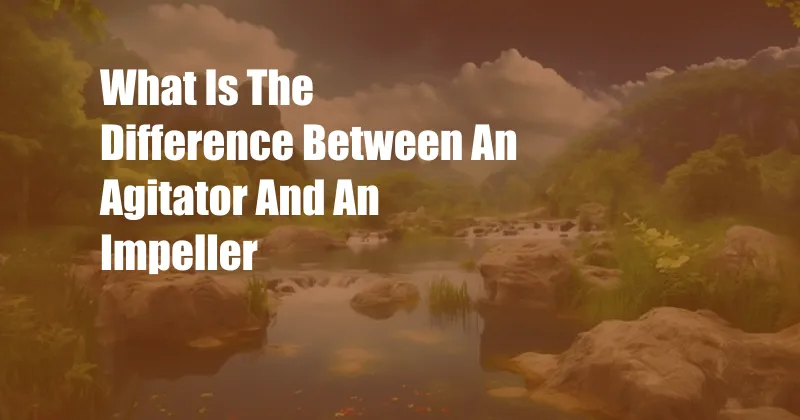
Agitators vs Impellers: Unveiling the Differences in Design and Function
Have you ever wondered about the subtle yet crucial distinctions between agitators and impellers? While both these components play a vital role in various industrial and scientific applications, they possess distinct characteristics and serve different purposes. In this comprehensive guide, we will delve into the intricate world of agitators and impellers, exploring their definitions, history, and the nuances that set them apart.
The Anatomy of an Agitator
An agitator, also known as a stirrer, is a mechanical device designed to induce agitation within a fluid or suspension. Its primary function is to enhance mixing, promote heat transfer, prevent sedimentation, and facilitate chemical reactions. Agitators come in various shapes and sizes, each tailored to specific applications.
The Purpose of an Impeller
An impeller, on the other hand, is a rotating component that provides the driving force for agitation. It is mounted on the shaft of an agitator and interacts directly with the fluid. The design of the impeller, including its shape, size, and pitch, influences the pattern and intensity of agitation.
Key Differences: Unraveling the Distinctions
- Purpose: Agitators facilitate agitation, while impellers generate the necessary force for agitation.
- Configuration: Agitators consist of rotating impellers mounted on a shaft, while impellers are the rotating blades responsible for agitation.
- Function: Agitators enhance mixing, heat transfer, and prevent sedimentation, whereas impellers provide the driving force for agitation.
- Design: Agitators and impellers come in various designs based on specific application requirements. Agitator designs can include propellers, paddles, and turbines, while impeller designs vary based on blade shape, pitch, and number.
- Applications: Agitators and impellers find applications in a wide range of industries, including chemical processing, food processing, pharmaceuticals, and wastewater treatment.
Latest Trends and Developments in Agitator and Impeller Design
The world of agitators and impellers is constantly evolving, with advancements driven by technological innovation and industry demands. Here are some notable trends:
- Energy-Efficient Designs: The increasing focus on sustainability has led to the development of energy-efficient agitator and impeller designs. These designs optimize flow patterns and reduce energy consumption while maintaining agitation performance.
- Computational Fluid Dynamics (CFD) Modeling: CFD simulations have become invaluable in designing and optimizing agitators and impellers. CFD models predict fluid flow patterns and allow engineers to fine-tune impeller geometry for maximum efficiency.
- Smart Impellers: The integration of sensors and control systems enables smart impellers that can adjust their speed and pitch based on fluid conditions. This enhances agitation performance and reduces energy consumption.
Expert Tips for Optimizing Agitator and Impeller Performance
- Match to Application: Carefully consider the fluid properties, desired level of agitation, and vessel geometry when selecting an agitator or impeller.
- Proper Impeller Selection: Choose the impeller type, size, and pitch that aligns with the desired mixing pattern and intensity.
- Placement and Orientation: Position the agitator and impeller strategically to maximize agitation and minimize power consumption.
- Maintenance and Monitoring: Regular maintenance and monitoring are essential to ensure optimal performance and prevent unexpected failures.
- Consult Industry Experts: Engage with experienced engineers or technical specialists for guidance on selecting and optimizing agitator-impeller systems.
FAQs: Answering Common Questions
Q: Can I use an impeller without an agitator?
A: No, an impeller requires an agitator to provide support and rotation.
Q: What is the difference between a paddle agitator and a turbine agitator?
A: Paddle agitators gently mix fluids, while turbine agitators provide high-intensity agitation.
Q: How often should I replace the impeller on my agitator?
A: Impeller replacement frequency depends on operating conditions. Consult the manufacturer’s recommendations or a qualified technician for guidance.
Conclusion
Agitators and impellers, although closely intertwined, play distinct roles in fluid agitation. By understanding the differences between these components, choosing the right ones for specific applications, and following expert tips, industries can optimize agitation processes for enhanced efficiency and performance. If you have any further questions or would like to explore the topic in more depth, feel free to reach out to us. We would be delighted to assist you on your journey to mastering the intricacies of agitation.